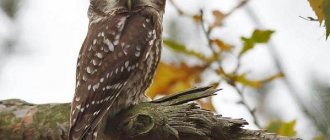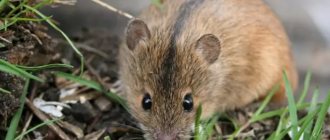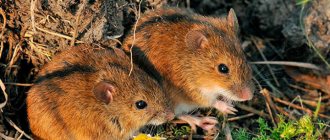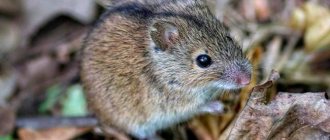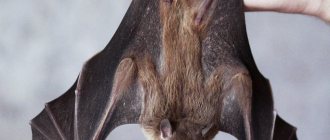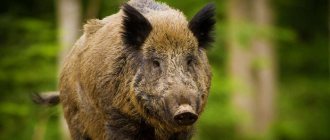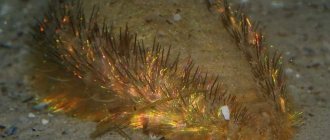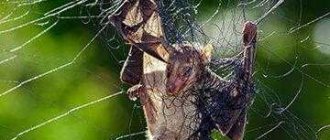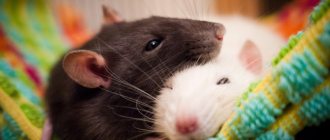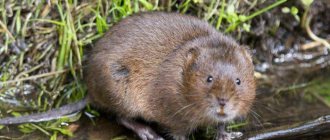The field mouse is an animal known for its fertility and adaptability. The vole mouse is found in almost all climatic zones, but it does not live in deserts, tropical forests and the Arctic zone, does not climb high into the mountains and tries to avoid wetlands and very wet areas. In all other areas you can find one or another variety of field mouse. In total, about 60 species of field mice are known; they are very similar in habits and appearance; it is difficult for a non-specialist to distinguish between them. What all species of field mice have in common is their ability to cause damage to humans and agriculture. Field mice are the most common type of rodent pest.
Description
The field mouse is a rodent up to 12 cm in size, 70 percent of its body length is its tail. The mouse has a pointed muzzle with whiskers, beady eyes and round ears. The body is covered with thick short hair. The color depends on the living conditions - from light red to dark brown. The fur on the belly is lighter. In young individuals, the color is more intense; in older individuals, the coat becomes lighter and grayer if the mouse lives to an old age. A distinctive feature of all voles is a dark stripe running along the upper back.
The hind legs are longer than the front legs. The claws on all paws wear down because mice are constantly digging for food. The mouse can hold food with its front paws. Voles move quickly: they run, jump and swim.
Field mice have many natural enemies, so they rarely live long. We can say approximately how long a vole lives. Under favorable conditions and the absence of enemies, a mouse can even live up to ten years.
In appearance and body length, the field mouse differs little from house mice. Both types of rodents can coexist in the same territory, in the same household: brownies go out into the garden in search of food, field rodents sneak into the house.
Field mice, like many other species of rodents, have teeth that grow throughout their lives, so the animals have to grind them down. If this is not done, the animal will die.
Is the vole an omnivore?
Basically, the diet of voles consists of plant foods, but they also do not disdain small insects and larvae, eating them in large quantities (especially in the spring and summer).
In winter cold, field mice often rush closer to warmth and attack residential buildings, warehouses, and settle in large numbers in stacks of bread.
Having chosen a house for the winter, the vole does not have to choose what to eat, so it eats everything that it can steal: cheese, sausage, lard.
Lifestyle and habitats
Field mice live in families that include several generations. They are quite peaceful, do not aggressively divide the territory, and can get along with other families in the same area.
Mice do not hibernate during the winter. They endure cold weather, store supplies for the winter, dig quite deep holes with a large number of passages, storage rooms for supplies, and bedrooms. In wet and swampy areas, they do not dig holes, but build nests in trees and bushes, adapting to almost any living conditions.
Field mice typically live close to humans. For example, they can overwinter in stacks and sheaves left in fields. They also like to settle for temporary or permanent residence in deposits of construction and other waste, in barns, basements, cellars - where food can be found.
Field mice are predominantly nocturnal. The animals are very voracious; in a day, mice can eat a volume of food equal to their own weight.
What does it eat?
What are the food preferences of a rodent, since it chews literally everything that comes its way? He is capable of even such addictions that are difficult to even imagine. They chew holes in wooden, concrete or brick structures. Their diet includes products made from foam, plastic or rubber, as well as products from other synthetic materials.
It is not difficult to assume that such interest is associated with the growth of the rodent’s front teeth. As food, mammals prefer grains, seeds and succulent parts of various plants, including young shoots, seedlings, vegetables and fruits. They often supplement their diet with worms, insects, eggs and chicks.
In a person’s home, the vole mouse spoils any food products, but does not disdain grain, bulk food products, vegetables, fruits, meat, lard, sausage, etc.
Interesting to know! The vole mouse stores for the winter if it is in the field, and during the winter it eats everything that it managed to collect during the warm period. As for other representatives of this family that were able to gain access to human reserves, they do not care about supplies for the winter. The rodent stores for itself for the winter food items that are edible. In this case, the amount of reserves depends on the size of the mink.
During the day, the mouse eats no more than 5 g of food and drinks up to 20 ml of liquid. Instead of water, rodents consume succulent parts of plants. Around mid-summer, the animal begins to make supplies for the winter.
What harm do voles do to mice?
As mentioned above, mice are constantly forced to chew something in order to wear down their ever-growing teeth. Because of this, they damage fruit plants and their roots. They can also gnaw passages in wooden, brick and concrete buildings, in home and garden furniture.
Mice spoil the harvest - in the field, vegetable garden and garden. They eat any fruits, buds, inflorescences and whole plants. They also disrupt the root system of plants, intensively breaking through tunnels in the ground.
If mice make their way into a barn, basement, basement, grain or vegetable storage, they destroy or severely spoil the products stored there. Moreover, they not only eat them, but also leave their feces on them. It is also worth considering that these are very active animals that are found in a variety of places, including garbage dumps. Moving around the surrounding area, they carry pathogens of dangerous diseases on their paws and fur: tularemia, toxoplasmosis, typhoid, leptospirosis and others.
Field mice are small and dangerous pests
Mice are rarely spoken of in a respectful tone. They are usually described as poor, shy, but very harmful rodents. The vole mouse is no exception.
This small animal can significantly spoil the harvest in the garden, and chew a hole in the floor at home. Judging by the photo, voles look like ordinary mice and rats. At the same time, the muzzles of the inhabitants of the fields are smaller, and the ears and tail are shorter.
Rodent control
There are benefits from field mice and other types of small rodents. First, they carry plant seeds, helping to expand their range. Secondly, they are an important part of the food chain. Field mice have many enemies in nature: owls and other birds of prey, foxes, wolves, and other predators. One owl eats up to a thousand mice a year. The presence of natural enemies prevents the mouse population from becoming too large. But when the conditions are favorable for them, there is plenty of food, there is a place where they can hide from predators, there can be a lot of field mice. Such favorable conditions, as a rule, are close to a person: in the garden of a private house, in a country house. In this case, the natural enemy becomes a domestic cat or a hunting dog. This is good protection against mice.
If there is no cat or dog, you need to choose one of the methods of struggle:
- Destruction using mousetraps, traps. They come in different types: traps, loop traps, etc. Glue traps are common: glue is applied to a sheet of paper or cardboard, to which the rodent sticks. Such glue, for example, is produced by Moscow. The glue does not dry out within two weeks and does not lose its adhesive properties. It is intended for use by the population in everyday life. This method of control is effective when there are a small number of rodents on the site.
- Ultrasound or vibration repellent. There are special devices that emit sound that is unbearable for mice. A person does not feel it. There are also devices that are inserted into a mouse hole: they vibrate and literally drive mice out of the area.
- Repelling with improvised means. Strong odors are unpleasant for field mice: turpentine, kerosene, vinegar, essential oils. You can soak rags with these products and lay them out on mouse paths. Mice also do not like ash: it can be scattered next to supplies so that pests do not get to them. You can also scare away field mice from the area by planting elderberries, garlic, and calendula on it.
- Baits with poison. The simplest option is to add gypsum to mice treats: it will become soggy in the stomach, swell and form a plug. You can also mix food that is attractive to mice with crushed glass. But the most effective way is bait with a special means for killing mice. Such chemicals in the form of ready-made baits or gels for adding to baits are produced, for example, by Mediret gel based on 0.1% bromadiolone. The product, 20-30 g, is placed in small containers (such as bait boxes, trays, boxes), plastic containers, on substrates made of thick paper, polyethylene, plastic. The product is placed in the habitats of rats and house mice. Indoors, containers with bait are placed along the paths of movement of rodents and especially in corners, along walls and partitions, under furniture, near burrows. Place the bait in dry places. The distance between the locations of the bait containers varies from 1 to 15 m, depending on the area of the room, its clutter, as well as the type and number of rodents. When the number of rodents is high, the bait is laid out frequently and in small portions.
When choosing a means to combat field mice, it is important to remember that a poisoned rodent can be eaten or bitten by a domestic animal, which can lead to its poisoning and even death.
It is impossible to completely destroy all mice, but it is possible and necessary to control their number. To prevent them from bothering you, it is important to keep the area and house in order, and to prevent the formation of debris deposits in which voles could live. In the house, it is important to keep food in closed packages and containers and clean it regularly. When mice appear, it is important to start fighting immediately, rather than waiting for the population to rapidly increase.
Diet
The diet of field mice is quite varied and varies depending on the “place of residence” .
The animal feeds very actively and can eat as much food in a day as it weighs.
- In the steppe . The vole usually feeds on grasses and plant roots, insect larvae, and cereals;
- In the meadow . The field mouse eats succulent stems and bulbs of plants, grass seeds, various berries, and small insects;
- In the forest . Field mice can often be found on forest edges; they eagerly eat tree bark, green leaves, buds, young shoots of bushes, mushrooms, nuts and berries;
- In the taiga . The field mouse, which lives in Siberian forests, is slightly different in color; its fur has a reddish tint. In the taiga, the vole has something to eat: lingonberries, cranberries, nuts, various small insects, cones, buds and tree leaves.
Reproduction and lifespan
Reproduction of field mice begins with the arrival of warm weather and continues until the first frost. The female bears the offspring for 18–22 days. Usually from 4 to 8 cubs are born. A mouse can become pregnant up to 8 times a year, but more often this happens 3 to 5 times.
Mice are born naked, blind and deaf. They grow quickly, after 2 weeks they see, hear and can run. After 3.5 - 4 weeks they become independent, and after 2 - 2.5 months they reach sexual maturity.
Little mice
How long a vole mouse lives depends largely on its living conditions. The average lifespan rarely exceeds 1.5 - 2 years, but some mice live 5 - 8 years.
Spreading
Field mice are quite widespread throughout the globe. Important factors that determine their residence in a particular area are the presence of vegetation and sufficient humidity.
Habitat
The vole can be found in many parts of the world. These mice live:
- in Central and Eastern Europe;
- in Mongolia, Korea, China;
- In Kazakhstan;
- in the Urals and southern Siberia;
- in North America;
- in the northern regions of India, in Libya.
Field mice are found in the Ciscaucasia, the Baltic states, and on the coast of the Azov and Black Seas.
Habitats
Voles prefer to inhabit open spaces, for example, meadows, fields, and sparse thickets of bushes. In cities they settle in parks, gardens, and cemeteries. The home of field mice is either natural shelters or holes dug at a depth of 10 cm. The vole's hole is quite simple. It consists of 1-2 nesting chambers, which are connected by tunnels with 3-4 exits to the surface. Voles living in flooded or swampy areas can do without burrows, making nests on the grass or in the branches of bushes.
